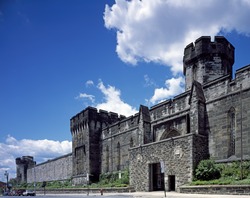
Back سجن الولايه الشرقيه ARZ Eastern State Penitentiary German Eastern State Penitentiary French Eastern State Penitentiary Hungarian Lembaga Pemasyarakatan Negara Bagian Timur ID Eastern State Penitentiary Dutch Eastern State Penitentiary Swedish Східна державна виправна колонія Ukrainian 东州教养所 Chinese
 The exterior of the Eastern State Penitentiary. | |
 | |
| Location | 2027 Fairmount Avenue Philadelphia, Pennsylvania |
|---|---|
| Coordinates | 39°58′6″N 75°10′21″W / 39.96833°N 75.17250°W |
| Status | Closed (now a museum) |
| Population | ~400 prisoners (from 1829 to 1877) |
| Opened | 1829 |
| Closed | 1971 |
| Warden | Samuel R. Wood (1829-40) Robert McKenty (1908-1923)[1] |
| Website | easternstate |
Eastern State Penitentiary | |
| Area | 11 acres (45,000 m2)[2] |
| Built | 1829 |
| Architect | John Haviland |
| Architectural style | Gothic Revival |
| NRHP reference No. | 66000680 |
| Significant dates | |
| Added to NRHP | October 15, 1966[4] |
| Designated NHL | June 23, 1965[5] |
| Designated PHMC | May 2, 1996[3] |
The Eastern State Penitentiary (ESP) is a former American prison in Philadelphia, Pennsylvania.[6] It is located in the Fairmount section of the city, and was operational from 1829 until 1971. The penitentiary refined the revolutionary system of separate incarceration, first pioneered at the Walnut Street Jail, which emphasized principles of reform rather than punishment.[7]
Notorious criminals such as Al Capone and bank robber Willie Sutton were held inside its innovative wagon wheel design. For their role in the Kelayres massacre of 1934, James Bruno (Big Joe) and several male relatives were incarcerated here between 1936 and 1948, before they were paroled.[8] At its completion, the building was the largest and most expensive public structure ever erected in the United States,[9] and quickly became a model for more than 300 prisons worldwide.
The prison is currently a U.S. National Historic Landmark,[5] which is open to the public as a museum for tours daily.
- ^ "Warden Robert McKenty". September 26, 2014. Archived from the original on December 17, 2021. Retrieved December 17, 2021.
- ^ "ESP :: History :: Timeline". Archived from the original on June 20, 2006. Retrieved May 4, 2016.
- ^ "PHMC Historical Markers". Historical Marker Database. Pennsylvania Historical & Museum Commission. Archived from the original on December 7, 2013. Retrieved December 10, 2013.
- ^ "National Register Information System". National Register of Historic Places. National Park Service. January 23, 2007.
- ^ a b "Eastern State Penitentiary". National Historic Landmark summary listing. National Park Service. Archived from the original on June 6, 2008. Retrieved January 9, 2008.
- ^ "Home | Eastern State Penitentiary". Easternstate.org. February 2, 2016. Archived from the original on February 20, 2022. Retrieved February 19, 2016.
- ^ Paul Kahan, Eastern State Penitentiary: A History (Charleston, SC: The History Press, 2008)
- ^ King of the Mountain The Bruno Family Story by Bruce Boyd 2016
- ^ Johnston, Norman. Eastern State Penitentiary: Crucible of Good Intentions. Philadelphia: Philadelphia Museum of Art, 1994.


